Saint Ita (also known as Itha, Ida, Ide, Deirdre, Dorothy) is the second most popular Irish woman saint after St. Brigid. She is venerated in Ireland by Orthodox and Catholic believers to this day. However, her life was written several centuries after her repose.
The future saint was born in about 480 into a Christian family near the present-day town of Waterford in the county of the same name—situated in the Munster province in the southeast of Ireland. Her father was a local chieftain. The girl was baptized with the name “Deirdre”). From childhood she was distinguished by her zeal and desire for the ascetic life. Everyone noted a special purity, meekness, kindness, presence of the grace of God and holiness in the child. To the great amazement of the adults, the future abbess observed a very strict fast from her cradle. One night her parents saw that their little daughter’s bedroom for some while was filled with an unusual fire which was understood to be divine grace.
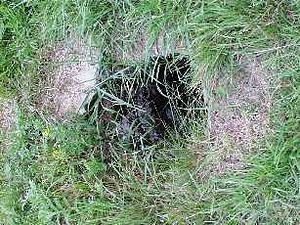
So in the wilderness the holy woman founded Killeedy Convent near Limerick in present-day County Limerick (situated in Munster in the south-west of Ireland), becoming its first abbess. The convent was situated at the foot of a mountain and it was the first monastic community founded in that district. The name “Killeedy” means “cell, or church of Ita”. The original name of this site presumably meant “the meadow of faith”. The convent of Killeedy was noted for its particular veneration of the Holy and Undivided Trinity. Tradition holds that St. Ita, who also had a keen interest in music, composed a famous lullaby to the Infant Christ which is used to this day.
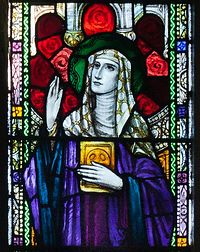 A stained glass image of St. Ita inside RC Church of the Mother of God and St. Kieran at Ballylooby, co. Tipperary
A stained glass image of St. Ita inside RC Church of the Mother of God and St. Kieran at Ballylooby, co. Tipperary
St. Ita used to say that the Lord loves three things in a Christian most of all: faith in God with a pure heart, a spiritual Christian life with simplicity, and generous love; but the Lord especially dislikes in us the following things: a gloomy face (according to another variant: hatred in our hearts), persistence in sin and excessive reliance on money.
St. Ita had a special gift: she combined the qualities of a caring mother and a skilled spiritual guide. The holy and loving Abbess Ita never left her convent, unlike St. Brigid, her great contemporary, who founded many convents and used to travel extensively. St. Ita’s austere and simple life and thirst for holiness attracted many women to her from the Emerald Island, and they entered her community in large numbers. Thus was fulfilled the prophecy that her parents had received many years before: that many people’s souls would be saved through St. Ita. Following the example of their spiritual mother, the convent sisters generously helped the needy and the elderly, cared for the sick, taught and cared for children. Manual work was encouraged in the community as well: the convent had a wonderful vegetable garden; it also owned a dairy at some distance from Killeedy.
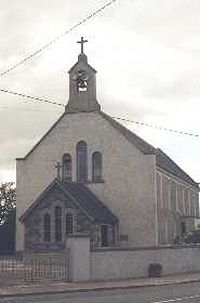 Kilmeedy church, county Limerick
Kilmeedy church, county Limerick
The Saviour abundantly bestowed on St. Ita the gift of wisdom. Interestingly, she gained her great wisdom not from learned books or experience of secular life (that she, in fact, did not have), but from her meditations on Divine things, her humble Christian life, meek and silent kneeling prayers and tears day and night. Already during her life Irish people from all corners of the island venerated St. Ita as a saint. Many of them desired to visit her convent despite the long distances and journeys—just to see this venerable woman, a living saint. St. Ita became known as a wonderworker, she possessed the gifts of spiritual discernment and clairvoyance and was famous for her prophecies.
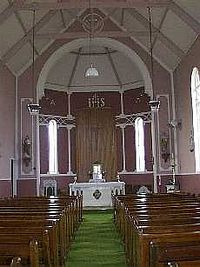 Altar of the Kilmeedy church
Altar of the Kilmeedy church
St. Ita lived an extremely long life, dying at the age of 90. Feeling that her end was near, she gathered her convent sisters, invoked the blessing of the Lord upon all of them as well as on all the priests, monks, nuns and laypeople in the surrounding region. This holy abbess passed away in the Lord following a torturous illness in about 570. The veneration of this saint spread all over Ireland; in the eighth century the learned monk Alcuin mentioned St. Ita in his poem dedicated to the saints of Ireland. The convent of St. Ita in Killeedy, a great centre of holiness and learning, existed till the ninth-century Viking raids. Soon after it had been destroyed for the first time by pirates in 845, a new church was built on the same site but this too was destroyed in the early tenth century.
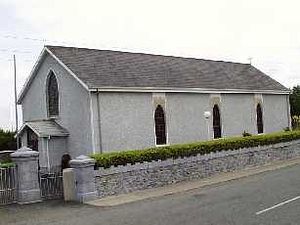 Raheenagh church, county Limerick
Raheenagh church, county Limerick
|
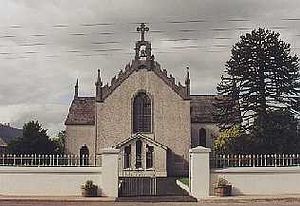 Feenagh church, co. Limerick
Feenagh church, co. Limerick
|
Only minor ruins survive of the once famous and important convent of St. Ita in Killeedy which is now a parish in County Limerick. This site, however, remains a destination for pilgrimages to this day. The supposed grave of St. Ita (now marked by a modern shrine with a statue of the saint) is located nearby. Locals and pilgrims frequently decorate it with flowers, and a solemn Catholic service is celebrated annually on January 15 in surrounding churches with different festive events dedicated to the holy patroness. Next to her grave there is a partly surviving ancient holy well associated with Ita: its full name is “the holy well of my little Ita.” Its water once healed many children from smallpox and other diseases and nowadays there have been cases of healing of local schoolchildren from warts. Tradition says that the well here first gushed forth during St. Ita’s lifetime. St. Ita is the patroness of children (especially of those studying), pregnant women, and those with various eye diseases.
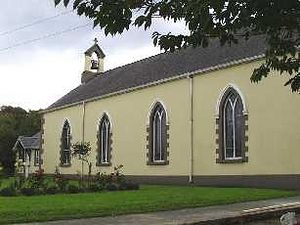 Ashford church
Ashford church
|
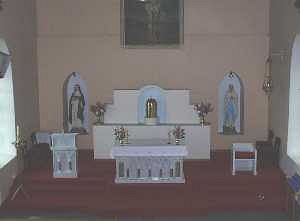 Ashford church altar
Ashford church altar
|
Two villages stand very near to the site of St. Ita’s former convent: Ashford and Raheenagh; the holy abbess is venerated here to this day and each of these villages has a church dedicated to St. Ita. In County Limerick there is also a village with the touching name of Kilmeedy which means “church of my little Ita”. According to tradition, here the saint built her first church before moving to Killeedy. Parish churches in Kilmeedy and the neighbouring village Feenagh (meaning “a wooded place”) are dedicated to St. Ita as well. “Ita” is still a girls’ baptismal name in Ireland.
Holy Mother Ita, Wonderworker of Limerick and all Ireland, pray to God for us!

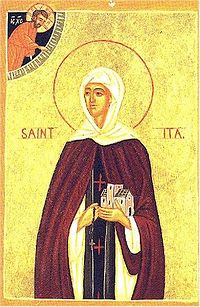
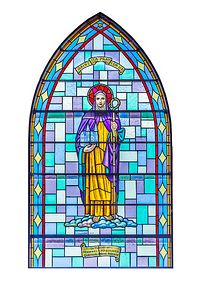
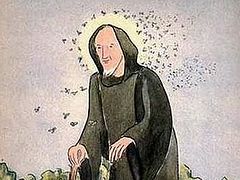
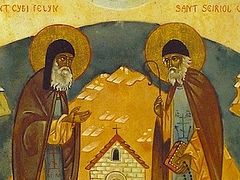
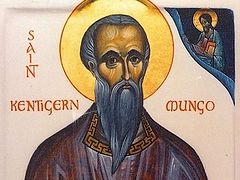
And pure as the driven snow,
A saint of our sainted island
Serving God long ago.
Oh, she had riches and suitors
Where royal Decies stood,
But gave up all for a lover
Who shed for her His Blood.
"Depart", cried a voice, "from kindred,
And from thy father's lands;
Make haste to a distant region,
Where dark-browed Loochar stands.
Wild warriors there shall build thee
A home by the mountain side;
Hy-Connaill bloom as a garden,
And bless thee far and wide. "
And clansmen and maidens gathered
Around that white-robed dove;
And the land served God as a virgin,
All, all of that virgin's love.
O, gem of our Church, fair Ita,
Maid of our worship and love,
Pray for our priests and people,
Saint of the heavens above.
Sing, sing ye a maiden holy,
And pure as the driven snow,
A saint of our sainted island
Serving God long ago.